United States Park Police
| United States Park Police | |
|---|---|
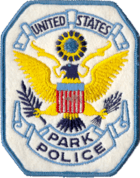 | |
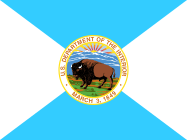 Flag of the U.S. Department of the Interior | |
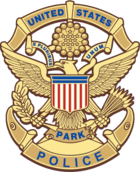 | |
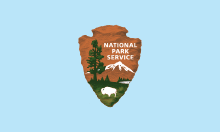 Flag of the U.S. National Park Service | |
| Common name | U.S. Park Police |
| Abbreviation | USPP |
| Motto | Integrity, Honor, Service |
| Agency overview | |
| Formed | 1919 |
| Preceding agency |
|
| Jurisdictional structure | |
| Federal agency (Operations jurisdiction) | United States |
| Operations jurisdiction | United States |
| Legal jurisdiction | National Park Service areas, primarily located in the Washington, D.C., San Francisco, and New York City areas and certain other government lands. |
| General nature | • Federal law enforcement |
| Headquarters | Washington, D.C. |
|
| |
| Agency executive |
|
| Parent agency | National Park Service |
| Website | |
| http://www.nps.gov/uspp/ | |
The United States Park Police (USPP) is one of the oldest uniformed federal law enforcement agencies in the United States. It functions as a full-service law enforcement agency with responsibilities and jurisdiction in those National Park Service areas primarily located in the Washington, D.C., San Francisco, and New York City areas and certain other government lands. The United States Park Police is one of the few full-service police departments in the federal government that possess both state and federal authority. In addition to performing the normal crime prevention, investigation, and apprehension functions of an urban police force, the Park Police are responsible for policing many of the famous monuments in the United States.
The USPP shares law enforcement jurisdiction in all lands administered by the National Park Service with a force of National Park Service Rangers tasked with the same law enforcement powers and responsibilities. The agency also provides protection for the President, Secretary of the Interior, and visiting dignitaries. The Park Police is a unit of the National Park Service, which is a bureau of the Department of the Interior.
History
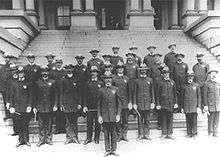
The Park Watchmen were first recruited in 1791 by George Washington to protect federal property only in the District of Columbia. The Watchmen were given the same powers and duties as the Metropolitan Police of Washington in 1882, and their name was officially changed to the present United States Park Police in 1919. Their authority first began to expand outside D.C. in 1929, and today they are primarily responsible for the Gateway National Recreation Area units within New York City and the Golden Gate National Recreation Area in San Francisco, as well as the many designated areas in the Washington area, which includes neighboring counties in Maryland and Virginia. These sites include the National Mall, the C&O Canal towpath in the region, and the parallel roadways of the George Washington Memorial Parkway in Virginia and Clara Barton Parkway in Maryland.
The police functioned as an independent agency of the federal government until 1849, when it was placed under the jurisdiction of the Department of the Interior. In 1867, Congress transferred the police to the Office of Public Buildings and Grounds, under the supervision of the Chief of Engineers of the Army Corps of Engineers. In 1925, Congress placed the Park Police in the independent Office of Public Buildings and Public Parks of the National Capital. Headed by an Army officer, Lt. Col. Ulysses S. Grant III, the office reported directly to the President of the United States. In 1933, President Franklin Delano Roosevelt transferred the police to the National Park Service.
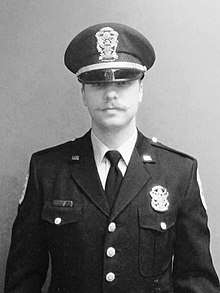
Authority
The United States Park Police was created by President George Washington in 1791. The Force functions as a unit of the National Park Service with jurisdiction in all Federal parks. U.S. Park Police officers are located in the Washington, DC, New York City, and San Francisco metropolitan areas, and investigate and detain persons suspected of committing offenses against the United States. Officers also carry out services for many notable events conducted in the national parks.[1]
Park Police have no authority to follow a vehicle outside their jurisdiction unless a felony has been committed.[2] According to Park Police policy, lethal force can only be used when there is "imminent danger of death or serious bodily harm".[3]
Operations
Park Police are forbidden from wearing body cameras while on the job. In a 2015 memo written by Chief MacLean, he told the entire force not to use any audio or video recorders "while on duty". MacLean claimed that the lack of a department-wide policy justified the ban on cameras.[4]
In 2018, DC Congressional Representative Eleanor Holmes Norton introduced a bill to require uniformed federal police officers to wear body cameras and have dashboard cameras in marked vehicles. Chief MacLean backed out of a scheduled meeting with Holmes Norton and Representative Don Beyer to discuss the matter, prompting Holmes Norton to make a statement to "express our astonishment" at his absence.[5]
Law enforcement
U.S. Park Police officers are charged with protecting National Icons such as the Statue of Liberty, the Washington Monument, the Lincoln Memorial, the Jefferson Memorial, and other well known monuments and memorials. This is accomplished through patrol efforts, coordination and assistance from the Intelligence/Counter-Terrorism Unit, and the Icon Protection Unit.[1]
2017 shooting of Bijan Ghaisar
In November 2017, Park Police shot and killed Bijan Ghaisar, an unarmed Virginia man after a hit and run and three separate vehicle pursuits. More than eight months after the incident, Park Police provided no explanation for the killing.[2] According to a lawsuit filed by the family, it was twelve hours following the incident before the family learned that Park Police were involved. Two days after the shooting, Park Police Chief Robert MacLean met with the family. MacLean offered condolences but provided no information about what had happened.[2] The Ghaisar family was not allowed to touch their son for three days following the incident, when he was guarded by the department’s officers.[2] According to the family, when a doctor arrived to examine Ghaisar for organ donation, the Park Police denied access, declaring the brain-dead man "under arrest" and his body "evidence."[2] More than nine months after the incident, Chief MacLean refused to speak to media about the incident, while Fairfax County Police, who filmed the shooting, said that the episode showed that greater transparency was needed. [6]
Other operations
In 2011, U.S. Park Police conducted an investigation after the arrest of five dancers at the Jefferson Memorial. In a video posted to YouTube, Park Police appeared to body slam and choke an individual who was silently dancing. The dance was in protest of the ban on dancing at memorials.[7]
U.S. Park Police played a role in the Washington Navy Yard shooting on September 16, 2013. Two U.S. Park Police officers, Andrew Wong and Carl Hiott, were involved in the response. The shooter was killed by D.C. Police Emergency Response Team officer Dorian DeSantis, who took fire, and a U.S Park Police Officer.[8]
In 2014, Park Police launched a crackdown on food truck operators. Park Police handcuffed food vendors who were selling to tourists on the National Mall. Vendors suggested that the enforcement was to protect the revenue from the government's food stands.[9] By September 2014, Park Police had arrested 196 people over the year for vending without a license on the mall. [10]
U.S Park Police Eagle 1 also conducted a rescue mission and removed an injured shooting victim from the roof of building 197 along with 3 other survivors ultimately saving their lives.[11]
In 2017, Park Police handcuffed teens who were selling water on the National Mall. The incident sparked public outrage and raised questions of racial disparities in enforcement. DC Councilmember Charles Allen asked whether arresting the teens was the appropriate response.[12]
Organization
Districts
In Virginia, USPP Officers are provided with Conservator of the Peace powers as set forth in 19.2-12 of the Code of Virginia[13] with powers and duties provided under 19.2-18 of the Code of Virginia.[14] In Washington, D.C. itself, USPP Officers have the same powers and duties as the D.C. Metropolitan Police. USPP Officers possess a limited arrest authority in the State of Maryland. The U.S. Park Police hold state arrest authority in New York [ New York State CPL 2.15 part 9 ], and state arrest authority in New Jersey [ New Jersey Code 2A:154-6 ]. In California, arrest powers are provided under California Penal Code Section 830.8. These state arrest powers are in addition to powers held as federal officers. The U.S. Park Police primarily enforce laws including but not limited to Title 36 of the Code of Federal Regulations (CFR) and other federal statutes such as 16 USC and 18 USC, as well as state and local laws.
The Guard Force
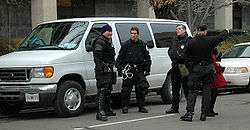
The USPP also oversees the Uniformed Guard Force which provides many urban National Park Service establishments with unarmed security guard and patrol services usually dealing with access and pass controls, key control, security patrols of buildings and facilities and assisting both the USPP and members of the public.
Communications
U.S. Park Police maintains communications centers which operate 24 hours a day seven days a week. One in the District of Columbia, one in San Francisco and two in the New York area. The Park Police oversees two dispatch (SF and NY) centers which also dispatch park EMS crews as well as park police officers. The centers are staffed by fully trained emergency dispatchers who handle a wide range of emergency calls for service, from shooting calls to suicide calls. The dispatchers have been credited with saving numerous civilian lives through specialized call taking (such as suicide call taking) and through quick deployment of officers to scenes as well as coordinating multi-agency police responses to scenes.
Aviation
The missions of the United States Park Police Aviation Unit include aviation support for law enforcement, medevac, search and rescue, high-risk prisoner transport and presidential and dignitary security. The Aviation Unit has provided accident-free, professional aviation services for over 40 years. This is due to the dedication of the flight crews, the support from within and outside the Force, and the state-of-art equipment used in the performance of its missions. They were the first helicopter provider of Air medical services within Washington, D.C, and continue to provide these services 24/7 to the district and neighboring jurisdictions.[15] They also provide an invaluable resource for patrolling and performing rescues at the numerous federal parks and recreation areas within the National Capital Region, such as Great Falls Park and Shenandoah National Park.[16] Like many park environments, injured parties in these remote and difficult to access locations require specialized rescue equipment to access and retrieve persons in distress. The US Park Police Aviation Unit is the primary resource for these remote rescues requiring helicopter access.
The Aviation Unit of the United States Park Police began in April 1973 and was placed under the command of Lt. Richard T. Chittick. It started with one Bell 206B JetRanger and a staff of three pilots and three rescue technicians based at the Anacostia Naval Air Station in a shared space with the MPD Aviation Branch. A second helicopter, a Bell 206B-3 JetRanger, was added in 1975 and the unit relocated to Andrews AFB.
The Aviation Unit moved to its present facility in Anacostia Park, the "Eagle's Nest," in 1976. In 1983, the 206B-3 was upgraded to a Bell206L-3 LongRanger. Their first twin-engine helicopter, a Bell 412SP, and the third helicopter to carry the designation "Eagle One," was placed in service in January 1991. The unit grew to its current staff, and began providing 24-hour coverage in January 1994.
In August 1999, the unit took delivery of its second twin-engine helicopter, a Bell 412EP. It became the fourth helicopter in the unit's history to carry the designation "Eagle One" and the same registration number as that of an earlier aircraft whose crew affected the rescue of victims after the crash of Air Florida Flight 90. In May 2016, the unit received a replacement for "Eagle Two" with a used & reconditioned Bell 412EP to replace the aging aircraft delivered in 1991.[17]
The crew of US Park Police Aviation resources are frequently called to assist at significant and historical disasters and emergency incidents throughout the National Capital Region. These incidents include the September 11 attacks on the Pentagon, the D.C. sniper attacks throughout the region, and the Washington Navy Yard shooting in 2013.[18] During the 2017 Congressional baseball shooting the crews of US Park Police Aviation responded with two helicopters and transported Congressman Steve Scalise and a US Capitol Police Officer to the trauma center at MedStar Washington Hospital Center.
Rank structure
| Title | Insignia |
|---|---|
| N/A |
Gallery
 One of the "tragedies" of the Easter egg rolling at the White House. At one time Sgt. McQuade of the White House Police had eight youngsters who had strayed from their parents. All were safely returned April 17, 1922
One of the "tragedies" of the Easter egg rolling at the White House. At one time Sgt. McQuade of the White House Police had eight youngsters who had strayed from their parents. All were safely returned April 17, 1922 A Chevrolet Impala police car used by the U.S. Park Police.
A Chevrolet Impala police car used by the U.S. Park Police. A Polaris Ranger off-road vehicle that is used by the U.S. Park Police.
A Polaris Ranger off-road vehicle that is used by the U.S. Park Police.- An officer from the U.S. Park Police Horse Mounted Unit
- U.S. Park Police helicopter patrolling the National Mall
See also
References
- 1 2 "United States Park Police (U.S. National Park Service)". Nps.gov. August 10, 2018. Retrieved September 10, 2018.
- 1 2 3 4 5 Tom Jackman and Michael Brice-Saddler (August 3, 2018). "Family of accountant shot dead by U.S. Park Police officers files $25 million lawsu=it". Washington Post. Washington DC. Retrieved August 4, 2018.
- ↑ Tom Jackman (January 24, 2018). "Video shows Park Police fired nine shots into Bijan Ghaisar's Jeep at close range, killing him". Washington Post. Washington DC. Retrieved January 24, 2018.
- ↑ MIRANDA GREEN (April 25, 2018). "Park Police officers were forbidden from wearing body cameras: memo". Washington Post. Washington DC. Retrieved April 25, 2018.
- ↑ Tom Jackman (February 13, 2018). "After Ghaisar killing, Park Police chief backs out of meeting on bill requiring body cams". Washington Post. Washington DC. Retrieved July 15, 2018.
- ↑ Paul Wagner (August 9, 2018). "US Park Police chief confronted about deadly shooting of Bijan Ghaisar". Fox News. Washington DC. Retrieved August 9, 2018.
- ↑ RUSSELL GOLDMAN (May 30, 2011). "Park Police Investigate Arrests for Dancing at Jefferson Memorials". ABC News. Washington DC. Retrieved May 30, 2011.
- ↑ Hermann, Peter (September 14, 2014). "Officer who shot Navy Yard gunman says it 'needed to be done'". The Washington Post. Retrieved September 10, 2018.
- ↑ Michelle Murillo (July 8, 2014). "Park Police Investigate Park police cracking down on Mall food trucks". WTOP. Washington DC. Retrieved July 8, 2014.
- ↑ Carman, Tim (September 23, 2014). "Food trucks on the Mall? Stationary vendors worry about the impending competition". Retrieved September 23, 2014.
- ↑ "For Park Police pilot Ken Burchell, Navy Yard shooting was unlike any other rescue mission". WTKR.com. September 18, 2015. Retrieved September 10, 2018.
- ↑ JANICE WILLIAMS (24 June 2017). "POLICE IN WASHINGTON D.C. ARREST BLACK TEENS FOR SELLING WATER BOTTLES, BECAUSE 'SAFETY'". Washington DC. Retrieved 24 June 2017.
- ↑ "Legislative Information System". Leg1.state.va.us. Retrieved September 10, 2018.
- ↑ "Legislative Information System". Leg1.state.va.us. Retrieved September 10, 2018.
- ↑ "Air medical providers". Doh.dc.gov. Retrieved September 10, 2018.
- ↑ "Elite National Park Service Helicopter Unit Marks Forty Years Of Service". National Parks Traveler.
- ↑ "Aviation to receive a 'New' Eagle". Usppfop.org. May 25, 2016. Retrieved September 10, 2018.
- ↑ https://www.usnews.com/news/articles/2013/09/16/dc-navy-yard-shooting-at-least-6-dead
External links
| Wikimedia Commons has media related to United States Park Police. |